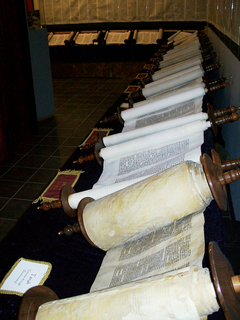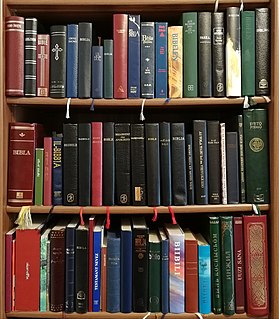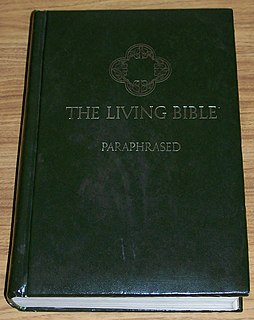
The New Testament (NT) is the second division of the Christian biblical canon. It discusses the teachings and person of Jesus, as well as events in first-century Christianity. The New Testament's background, the first division of the Christian Bible, is called the Old Testament, which is based primarily upon the Hebrew Bible; together they are regarded as sacred scripture by Christians.

The Hebrew Bible or Tanakh, also known in Hebrew as Miqra, is the canonical collection of Hebrew scriptures, including the Torah, the Nevi'im, and the Ketuvim. Different branches of Judaism and Samaritanism have maintained different versions of the canon, including the 3rd-century Septuagint text used by Second-Temple Judaism, the Syriac language Peshitta, the Samaritan Torah, the Dead Sea Scrolls, and most recently the 10th century medieval Masoretic text created by the Masoretes currently used in modern Rabbinic Judaism. The terms "Hebrew Bible" or "Hebrew Canon" are frequently confused with the Masoretic text, however, this is a medieval version and one of several texts considered authoritative by different types of Judaism throughout history. The modern Masoretic text is mostly in Biblical Hebrew, with a few passages in Biblical Aramaic.

The Geneva Bible is one of the most historically significant translations of the Bible into English, preceding the King James Version by 51 years. It was the primary Bible of 16th-century English Protestantism and was used by William Shakespeare, Oliver Cromwell, John Knox, John Donne, and others. It was one of the Bibles taken to America on the Mayflower. The Geneva Bible was used by many English Dissenters, and it was still respected by Oliver Cromwell's soldiers at the time of the English Civil War, in the booklet The Souldiers Pocket Bible.

The Bible has been translated into many languages from the biblical languages of Hebrew, Aramaic, and Greek. As of 2022 all of the Bible has been translated into 724 languages, the New Testament has been translated into an additional 1,617 languages, and smaller portions of the Bible have been translated into 1,248 other languages according to Wycliffe Global Alliance. Thus, at least some portions of the Bible have been translated into 3,589 languages.

Exegesis is a critical explanation or interpretation of a text. Traditionally, the term was used primarily for work with religious texts, especially the Bible. In modern usage, exegesis can involve critical interpretations of virtually any text, including not just religious texts but also philosophy, literature, or virtually any other genre of writing. The phrase biblical exegesis is now used to distinguish studies of the Bible from other critical textual explanations.
A study Bible is an edition of the Bible prepared for use by a serious student of the Bible. It provides scholarly information designed to help the reader gain a better understanding of and context for the text.
Partial Bible translations into languages of the English people can be traced back to the late 7th century, including translations into Old and Middle English. More than 100 complete translations into English have been written.

The New Living Translation (NLT) is an English translation of the Bible. The origin of the NLT came from a project aiming to revise The Living Bible (TLB). This effort eventually led to the creation of the NLT—a new translation separate from the LB. The NLT relies on critical editions of the original Hebrew and Greek texts. The first NLT edition retains some stylistic influences of the LB, but these are less evident in text revisions that have been published since.

The Living Bible is a personal paraphrase, not a translation, of the Bible in English by Kenneth N. Taylor and first published in 1971. Taylor used the American Standard Version of 1901 as his base text.
The Clear Word, originally published in March 1994 as the Clear Word Bible, is an English-language "devotional paraphrase of the Bible expanded for clarity". It is an interpretive representation of the Bible, written as a personal devotional exercise by Jack J. Blanco, former dean of the School of Religion at Southern Adventist University, and to be used as a devotional tool alongside the Bible. However, major portions of the paraphrase are not based on underlying original language texts. It is printed in chapter-and-verse format, two columns to a page.

Biblical hermeneutics is the study of the principles of interpretation concerning the books of the Bible. It is part of the broader field of hermeneutics, which involves the study of principles of interpretation, both theory and methodology, for all forms of communication, nonverbal and verbal.

In Christian communities, Bible study is the study of the Bible by people as a personal religious or spiritual practice. In many Christian traditions, Bible study, coupled with Christian prayer, is known as doing devotions or devotional acts. Many Christian churches schedule time to engage in Bible study collectively. The origin of Bible study groups has its origin in early Christianity, when Church Fathers such as Origen and Jerome taught the Bible extensively to disciple Christians. In Christianity, Bible study has the purpose of "be[ing] taught and nourished by the Word of God" and "being formed and animated by the inspirational power conveyed by Scripture".

The historical-grammatical method is a modern Christian hermeneutical method that strives to discover the biblical authors' original intended meaning in the text. According to the historical-grammatical method, if based on an analysis of the grammatical style of a passage, it appears that the author intended to convey an account of events that actually happened, then the text should be taken as representing history; passages should only be interpreted symbolically, poetically, or allegorically if to the best of our understanding, that is what the writer intended to convey to the original audience. It is the primary method of interpretation for many conservative Protestant exegetes who reject the historical-critical method to various degrees, in contrast to the overwhelming reliance on historical-critical interpretation in biblical studies at the academic level.
There have been various debates concerning the proper family of biblical manuscripts and translation techniques that should be used to translate the Bible into other languages. Biblical translation has been employed since the first translations were made from the Hebrew Bible into Greek and Aramaic. Until the Late Middle Ages, the Western Church used the Latin Vulgate almost entirely while the Eastern Church, centered in Constantinople, mostly used the Greek Byzantine text. Beginning in the 14th century, there have been increasing numbers of vernacular translations into various languages. With the development of modern printing techniques, these increased enormously.

Jehovah is a Latinization of the Hebrew יְהֹוָהYəhōwā, one vocalization of the Tetragrammaton יהוה (YHWH), the proper name of the God of Israel in the Hebrew Bible/Old Testament. The Tetragrammaton יהוה is considered one of the seven names of God in Judaism and one of the names of God in Christianity.
Young's Analytical Concordance to the Bible is a Bible concordance to the King James Version compiled by Robert Young. First published in 1879, it contains "about 311,000 references subdivided under the Hebrew and Greek originals with the literal meaning and pronunciation of each."
Biblical software or Bible software is a group of computer applications designed to read, study and in some cases discuss biblical texts and concepts. Biblical software programs are similar to e-book readers in that they include digitally formatted books, may be used to display a wide variety of inspirational books and Bibles, and can be used on portable computers. However, biblical software is geared more toward word and phrase searches, accessing study bible notes and commentaries, referencing various modern translations, cross-referencing similar passages and topics, biblical dictionaries, original language texts and language tools, maps, charts, and other e-books deemed relevant to understanding texts from a philological approach.

Canonical criticism, sometimes called canon criticism or the canonical approach, is a way of interpreting the Bible that focuses on the text of the biblical canon itself as a finished product.
According to Dr. Naseeb Shaheen, Shakespeare, in writing his plays, "seldom borrows biblical references from his sources, even when those sources contain many references." Roy Battenhouse notes that the Shakespearean tragedy "frequently echoes Bible language or paradigm, even when the play's setting is pagan." Similarly, Peter Milward notes that despite their secular appearance, Shakespeare's plays "conceal an undercurrent of religious meaning which belongs to their deepest essence." Further, Milward maintains that although Shakespeare "may have felt obliged by the circumstances of the Elizabethan stage to avoid Biblical or other religious subjects for his plays," such obligation "did not prevent him from making full use of the Bible in dramatizing his secular sources and thus infusing into them a Biblical meaning." Milward continues that, in writing his plays, Shakespeare "shows the universal relevance of the Bible both to the reality of human life 'in this harsh world' and to its ideal in the heart of God." Steven Marx suggests "a thorough familiarity with the Scriptures" is a prerequisite to understanding the Biblical references in the plays, and that the plays' references to the Bible "illuminate fresh and surprising meanings in the biblical text." Marx further notes that "it is possible that Shakespeare sometimes regarded his own role of playwright and performer as godlike, his own book as potent and capacious as 'The Book'." It is important to note, as a recent study points out “The diversity of versions reflected in Shakespeare’s writing indicates that ‘Shakespeare’s Bible’ cannot be taken for granted as unitary, since it consists of a network of different translations”










